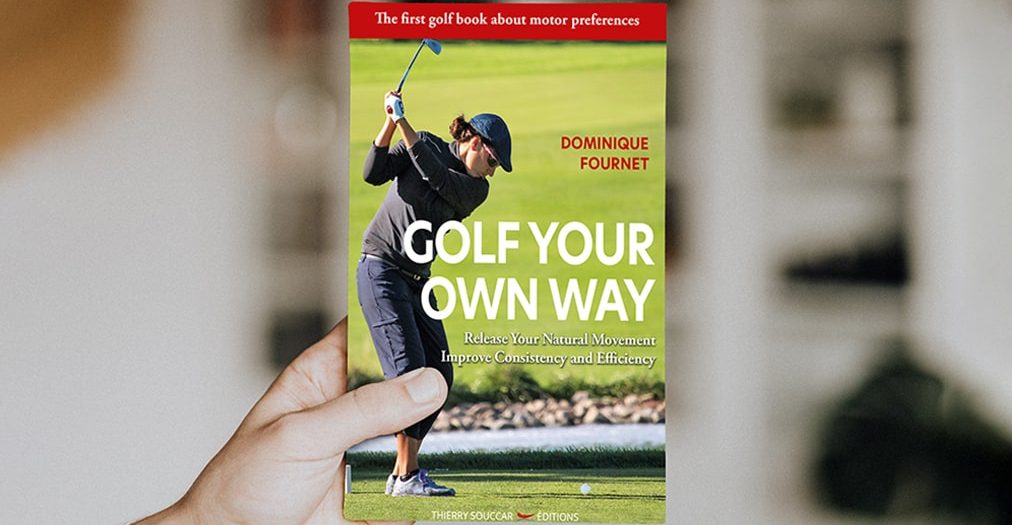Earlier in 2020, with the abundance of golf training videos on social medias, I asked myself why we were not all pros (in French). Truth be told, with all the tech tips available on YouTube and others, it should have been the case, right? Strangely no. And my answer was strengthen when I read a book called “À chacun son swing“. It has now been translated in English; “Golf your own way“. A simple title for a short book who can help you to understand that spending hours reading or watching training videos won’t help you to get better.
Beyond the title, Dominique Fournet and Marc Coureau wanted to translate their decades of experience condensed in a easy-to-read book, simple to assimilate and that every golfer should read. Do not click on the link just yet because you will not find the secret of golf in this book but a method to understand yourself and make golf a less complex sport than it seems. I made the most of our meeting to explain to you why this book should already be in your library.


A turnaround in the training method
Most of the technical advice that you see everywhere is a bit like a cooking recipe. The positioning of the ball in the stance, the rotation, the takeaway in this way, the contact of the ball, the divot, your gaze that rises, we close the club and the finish. Simple, the cake looks delicious. And in addition a real chef has just described it to you and done it in front of your eyes. You tell yourself that this weekend for the pro-am, slices and tops will be gone. Except that the taste of the cake is far from having the taste of the chef’s cake.
In the book, the approach is different, it is about doing the “opposite”.
Instead of starting from the technique, we start from the person to give him the best technique according to his characteristics.
Dominique Fournet
Indeed, it is difficult to act on the consequences by dealing with the consequences. The source of the swing is the person performing it. By understanding how it “moves” it will be easier to provide a solution. And it’s Marc who talks about it best.
Action Types® approach and motor preferences
In fact, it is a question of detecting to whom I have to do and what offers the motor preferences and the ActionTypes® approach. These are very simple benchmarks and are mostly binary. When talking about how to balance yourself, in a few minutes it can be seen. Whether the person is on the front or on the back. And that will have an influence on the movement she has to make and the type of information she needs and the way to communicate with her. The idea is to make visible what is not .
Marc Coureau
The ActionTypes® approach was developed from 1989, based on observations in the field by Bertrand Théraulaz and Ralph Hippolyte. Through 4 stages, they highlighted that with the same intention, athletes perform a different gesture with equal success, and that several specific motor profiles exist.
The question you need to ask yourself is: if the technical advice distilled in all these videos and lives on social networks can match me? Are they addressed to me?
No miracle recipe, but a different approach for simpler golf.
From the beginning, the book begins with Antoine who describes his situation. And to be honest we all more or less went through this.
Despite all these attempts, he no longer enjoys it. He tries one last time with motor preferences. And there, it is the click. Something changed. Through several “exercises”, he rediscovers golf. Besides, this is what happens throughout the book. After the discovery of motor preferences, the authors accompany us towards training. giving the floor after each exercise to Antoine who describes the result.
The first part is how my vehicle (my body) works and the second part is how the tool works.
Marc Coureau
An important point that you will not find in any other book (or almost, it is the way of training.
Here, no mechanical repetition of the gesture until perfection. With differential training, “we repeat the gesture without reproducing it “Dominique tells me. A totally different approach that pays off. When you think about it, it is difficult to find similar conditions on the course than on a practice mat, right?
Because internal and external conditions change as you go along, you have to adapt.
We try to control things. This is the paradox of golf that is explained in the book. It is a gesture that lasts 1 second. We are on the reflex. And we learn it by cracking the elements of swing.
Dominique Fournet
What to do with this book?
First of all, you have to buy it. For €9.90 (epub format), it will bring you much more than yet another bio on Tiger. In addition, this approach, provided by Axel Conseil, Dominique and Marc, is effective. After all, if that wasn’t the case, would they be there training in basketball or in Top 14 teams?
Secondly, don’t take it as a ready-made recipe to be a cracker. But if by listening and watching these technique videos your swing is in worse shape than you built it, it’s time to take another approach. An approach of over 20 years old but for the first time brought to you in a book.
And if the book is not enough, you can contact Axel Conseil for training. Finally, copyright is donated to the Alzheimer Research Foundation. A nice gesture that will only add to the fact that it must appear in your golf library.


